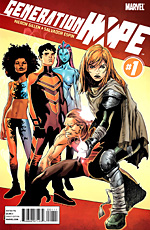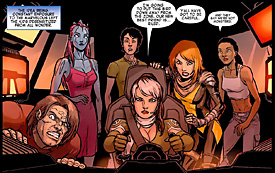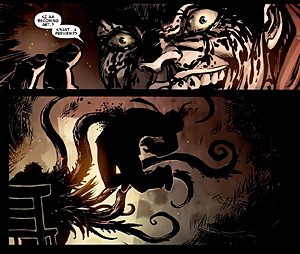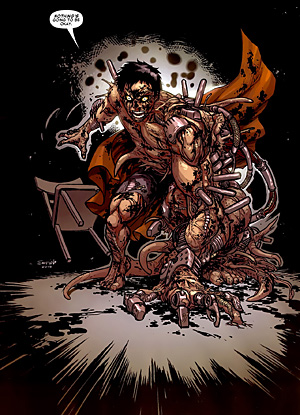 Written by Kieron Gillen
Written by Kieron Gillen
Art by Salvador Espin
40 pages, color
Published by Marvel
New comics in the X-Men family are a dime a dozen; often, with no warning, they just appear, seemingly spinning off characters at random. With Generation Hope, though, we’ve got two distinct differences from many other recent spin-offs. First, there isn’t an "X" anywhere in the title (although perhaps out of desperation, the logo creator put an X in Hope’s "O"). And second, this comic has actually spun directly out of a storyline, and appears to be moving forward with one of the big storylines happening in Uncanny X-Men and company. And so, as a result? I think this title has a real chance of succeeding.
 For those who haven’t been reading the X-Books over the past few years, the number of mutants on the planet has (mystically) been reduced to less than 200, and no new mutants were being born. Now, the only mutant to arrive post "M-Day" (who is already a teenager instead of a baby, but that’s a long story) is Hope, destined to become a mutant messiah. With her arrival have been the detection of five new mutants, and Hope and the X-Men have already tracked down the first four, with Hope having the power to stabilize their mutant abilities. And so, now, Hope and her new charges are heading towards Tokyo, seeking out the fifth and final brand new mutant, and that’s when things start to get difficult.
For those who haven’t been reading the X-Books over the past few years, the number of mutants on the planet has (mystically) been reduced to less than 200, and no new mutants were being born. Now, the only mutant to arrive post "M-Day" (who is already a teenager instead of a baby, but that’s a long story) is Hope, destined to become a mutant messiah. With her arrival have been the detection of five new mutants, and Hope and the X-Men have already tracked down the first four, with Hope having the power to stabilize their mutant abilities. And so, now, Hope and her new charges are heading towards Tokyo, seeking out the fifth and final brand new mutant, and that’s when things start to get difficult.
 Kieron Gillen, who recently had a stint on Thor as well as being the new co-writer on Uncanny X-Men (and whose comic Phonogram was one of the best comics of 2009), is heading up Generation Hope and it’s a good, solid first issue. Gillen assumes that no one’s read the stories leading up to this point, and he introduces each of the new characters in a swift but effective manner, getting into their heads and letting us see how they tick. So while it’s a quick character sketch for all (Idie in particular gets a strong focus), it’s enough to keep you feeling like you know what’s happening. He also shifts the tone that was previously set in Uncanny X-Men; there, the discovery of each of the "five lights" was an upbeat, positive thing. Here, it’s much darker and dank, and for the first time we’re getting the distinct impression that not all of the discovered mutants are necessarily going to be heroes.
Kieron Gillen, who recently had a stint on Thor as well as being the new co-writer on Uncanny X-Men (and whose comic Phonogram was one of the best comics of 2009), is heading up Generation Hope and it’s a good, solid first issue. Gillen assumes that no one’s read the stories leading up to this point, and he introduces each of the new characters in a swift but effective manner, getting into their heads and letting us see how they tick. So while it’s a quick character sketch for all (Idie in particular gets a strong focus), it’s enough to keep you feeling like you know what’s happening. He also shifts the tone that was previously set in Uncanny X-Men; there, the discovery of each of the "five lights" was an upbeat, positive thing. Here, it’s much darker and dank, and for the first time we’re getting the distinct impression that not all of the discovered mutants are necessarily going to be heroes.
Gillen’s script also deliberately contains a massive homage to Akira in the form of Kenji, the artist whose new mutant power is surging out of control and mutating his body. It’s a fun nod to the seminal comic by Katsuhiro Otomo, with limbs and machinery surging out of control in the same way that Tetsuo’s power rips through his body.  We’ve seen up until now some hints that these mutant powers aren’t all blessings (Teon’s greatly reduced intelligence, or Gabriel’s power having some possible bad side-effects) but this takes it full tilt into that arena. If anything, it gives extra import to the title of Generation Hope; after all, if everything is cheerful and rosy, it’s rather easy to be hopeful.
We’ve seen up until now some hints that these mutant powers aren’t all blessings (Teon’s greatly reduced intelligence, or Gabriel’s power having some possible bad side-effects) but this takes it full tilt into that arena. If anything, it gives extra import to the title of Generation Hope; after all, if everything is cheerful and rosy, it’s rather easy to be hopeful.
Salvador Espin draws Generation Hope #1, and it’s a nice, dark look for the title. The early scene where Kenji’s tentacles attack is creepy looking, using shadows and outlines to help create a visual that stands out almost instantly. Even when drawing slightly less stylized, such as the scenes with the kids aboard the plane, all of them stand out in their own special way, and it shows that he can draw lighter scenes that are no less crisp and attractive.
Espin also does a great job of aping Otomo’s art for the Akira homages; I mention that specifically because while Espin makes no bones about what it’s supposed to remind you of (this isn’t a hidden swipe going on here), it’s still drawn in his own style and doesn’t come across as a simple tracing or lightbox. It’s the best kind of homage, at the end of the day, and as someone who first started reading Akira over 20 years ago, it was a delight to see it show up so lovingly.
Unlike a lot of new titles these days, I feel like Generation Hope #1 hit the ground running in a way that kept my attention and made me want to read a second issue. That’s not something that happens too terribly often, quite frankly. It’s great to see such a strong debut, and hopefully it’s going to translate into equally strong sales. And, for those readers of Uncanny X-Men, it’s also a strong reassurance that his coming on board as co-writer shouldn’t be feared. There is, indeed, hope for the future of mutant kind.
